Spatiotemporal Dynamics and Drivers of Vegetation NPP in the Yanshan-Taihang Mountain Ecological Conservation Zone from 2004 to 2023
Abstract
1. Introduction
2. Materials and Methods
2.1. Study Area
2.2. Data and Processing
2.3. Research Method
2.3.1. Quantification of NPP Trends
2.3.2. Analysis of the Correlation Between NPP and Climatic Factors
2.3.3. Stability Analysis Using Coefficient of Variation
2.3.4. Identifying Driving Factors of NPP Using a Geographical Detector Model
2.3.5. Analysis of Long-Term Trends Using the Hurst Exponent
- A range of 0 < H < 0.5 indicates anti-persistent behavior, suggesting that future trends are likely to reverse the direction of past trends. The intensity of this mean-reverting characteristic strengthens as H approaches 0.
- A value of H = 0.5 signifies a random walk process, where the series lacks long-term memory and future changes are unpredictable.
- A range of 0.5 < H < 1 indicates persistent behavior, meaning the observed historical trend is likely to continue into the future. The strength of this trend-reinforcing behavior increases as H approaches 1.
3. Results and Analysis
3.1. Spatiotemporal Distribution Patterns of NPP in the YTECZ
3.1.1. Temporal Variation in Vegetation NPP
3.1.2. Spatial Heterogeneity of Vegetation NPP
3.2. Drivers of Vegetation NPP Dynamics
3.2.1. Geodetector-Based Factor Influence Analysis
3.2.2. Climatic Controls on Vegetation NPP
3.3. Spatiotemporal Trajectories of Vegetation NPP
3.3.1. Decadal Dynamics of NPP (2004–2023)
3.3.2. Projected Future Trajectories of Vegetation NPP
4. Discussion
5. Conclusions
- Spatiotemporal Patterns: Vegetation NPP exhibited a significantly increasing yet fluctuating trend, rising at an average annual increase of 4.58 g C·m−2yr−1. Spatially, a distinct “high in the northwest, low in the southeast” gradient was identified, reflecting the underlying influences of topography, land cover, and anthropogenic pressure.
- Driving Mechanisms: A key finding of this study is the fundamental scale-dependency of the driving mechanisms. Precipitation dominated the interannual variability of NPP, whereas VPD and temperature were the primary drivers of its spatial heterogeneity. This clear divergence highlights the necessity of distinguishing between temporal and spatial scales when diagnosing vegetation dynamics. Furthermore, the interaction between these factors, particularly the non-linear enhancement between VPD and human activities, adds another layer of complexity to the driving mechanisms.
- Future Sustainability and Implications: The future NPP trajectory is characterized by strong anti-persistence (Hurst exponent mean = 0.46), indicating that the current increasing trend is unlikely to be sustainable and may reverse in the future. This finding underscores the potential vulnerability of the region’s long-term carbon sequestration potential, posing challenges for climate resilience planning. Consequently, ecological management strategies should prioritize areas with persistent decline and incorporate the inherent instability of anti-persistent increases into long-term conservation planning.
Author Contributions
Funding
Data Availability Statement
Conflicts of Interest
References
- Gui, Y.; Wang, K.; Huntingford, C.; Wei, S.; Li, X.; Myneni, R.B.; Piao, S. Vegetation greenness in 2024. Nat. Rev. Earth Environ. 2025, 6, 255–257. [Google Scholar] [CrossRef]
- Wu, X.; Liang, J.; Du, D.; Xue, R.; Ding, X.; Wei, M.; Zhang, P. Spatial-temporal pattern and influencing factors of vegetation phenology and net primary productivity in the Qilian Mountains of Northwest China. Sustainability 2022, 14, 14337. [Google Scholar] [CrossRef]
- Piao, S.; Wang, X.; Park, T. Characteristics, drivers and feedbacks of global greening. Nat. Rev. Earth Environ. 2020, 1, 14–27. [Google Scholar] [CrossRef]
- Lieth, H.; Whittaker, R.H. Primary Productivity of the Biosphere; Springer: New York, NY, USA, 1975. [Google Scholar]
- Roxburgh, S.H.; Berry, S.L.; Buckley, T.N.; Barnes, B.; Roderick, M.L. What is NPP? Inconsistent accounting of respiratory fluxes in the definition of net primary production. Funct. Ecol. 2010, 19, 378–382. [Google Scholar] [CrossRef]
- Sun, Q.L.; Li, B.L.; Li, F.; Zhang, Z.J.; Ding, L.L.; Zhang, T.; Xu, L.L. Review on the estimation of net primary productivity of vegetation in the Three-River Headwater Region, China. Acta Geogr. Sin. 2016, 71, 1596–1612. (In Chinese) [Google Scholar] [CrossRef]
- Zhang, F.G.; Zeng, B.; Cao, Y.; Li, F.; Tang, Z.Y.; Qi, J.G. Human activities have markedly altered the pattern and trend of net primary production in the Ili River basin of Northwest China under current climate change. Land Degrad. Dev. 2022, 33, 2585–2595. [Google Scholar] [CrossRef]
- Afzali, A.; Hadian, F.; Sabri, S.; Yaghmaei, L. Investigating net primary production in climate regions of Khuzestan Province, Iran using CASA model. Int. J. Biometeorol. 2024, 68, 1357–1370. [Google Scholar] [CrossRef]
- Li, W.; Zhou, J.; Xu, Z.; Liang, Y.; Shi, J.; Zhao, X. Climate impact greater on vegetation NPP but human enhance benefits after the grain for green program in Loess Plateau. Ecol. Indic. 2023, 157, 111201. [Google Scholar] [CrossRef]
- Jin, K.; Wang, F.; Han, J.; Shi, S.; Ding, W. Contribution of climatic change and human activities to vegetation NDVI change over China during 1982–2015. Acta Geogr. Sin. 2020, 75, 961–974. (In Chinese) [Google Scholar] [CrossRef]
- Li, J.; Wang, Z.; Lai, C.; Wu, X.; Zeng, Z.; Chen, X.; Lian, Y. Response of net primary production to land use and land cover change in mainland China since the late 1980s. Sci. Total Environ. 2018, 639, 237–247. [Google Scholar] [CrossRef]
- Li, F.; Zhang, K.; Ren, J.; Yin, C.; Zhang, Y.; Nie, J. Driving mechanism for farmers to adopt improved agricultural systems in China: The case of rice-green manure crops rotation system. Agric. Syst. 2021, 192, 103202. [Google Scholar] [CrossRef]
- Lei, S.; Zhou, P.; Lin, J.; Tan, Z.; Huang, J.; Yan, P.; Chen, H. Spatiotemporal variation in carbon and water use efficiency and their influencing variables based on remote sensing data in the Nanling Mountains Region. Remote Sens. 2025, 17, 648. [Google Scholar] [CrossRef]
- Bulut, S.; Günlü, A.; Şatır, O. Estimating net primary productivity of semi-arid Crimean pine stands using biogeochemical modeling, remote sensing, and machine learning. Ecol. Inform. 2023, 76, 102137. [Google Scholar] [CrossRef]
- Cuo, L.; Zhang, Y.; Ri, X.; Zhou, B. Decadal change and inter-annual variability of net primary productivity on the Tibetan Plateau. Clim. Dyn. 2021, 56, 1837–1857. [Google Scholar] [CrossRef]
- Richter, G.; Topp, C. Climate factors contribute to grassland net primary productivity. Agronomy 2021, 11, 1076. [Google Scholar] [CrossRef]
- Peng, M.; Li, C.; Wang, P.; Dai, X. Spatio-temporal variation and future sustainability of net primary productivity from 2001 to 2021 in Hetao Irrigation District, Inner Mongolia. Agriculture 2024, 14, 613. [Google Scholar] [CrossRef]
- Liu, G.; Shao, Q.; Fan, J.; Ning, J.; Rong, K.; Huang, H.; Liu, S.; Zhang, X.; Niu, L.; Liu, J. Change trend and restoration potential of vegetation net primary productivity in China over the past 20 years. Remote Sens. 2022, 14, 1634. [Google Scholar] [CrossRef]
- Su, Y.; Chen, S.; Li, X.; Ma, S.; Xie, T.; Wang, J.; Yan, D.; Chen, J.; Feng, M.; Chen, F. Changes in vegetation greenness and its response to precipitation seasonality in Central Asia from 1982 to 2022. Environ. Res. Lett. 2023, 18, 104002. [Google Scholar] [CrossRef]
- Chang, S.; Gao, X.; Li, Q.; Song, X.; Lin, J. Threshold response of net primary productivity to climate change in the Qilian Mountains (2001–2022). Ecol. Indic. 2025, 178, 113900. [Google Scholar] [CrossRef]
- Lin, N.; Li, J.; Jiang, R.; Li, X.; Liu, S. Quantifying the spatiotemporal variation of NPP of different land cover types and the contribution of its associated factors in the Songnen Plain. Forests 2023, 14, 1841. [Google Scholar] [CrossRef]
- Zhao, Y.; Qie, X. Quantitative assessment of the relative impacts of climate change and human activities on net primary productivity of vegetation in the Beijing-Tianjin-Hebei Region. Front. Environ. Sci. 2024, 12, 1508433. [Google Scholar] [CrossRef]
- Nemani, R.R.; Keeling, C.D.; Hashimoto, H.; Jolly, W.M.; Piper, S.C.; Tucker, C.J.; Myneni, R.B.; Running, S.W. Climate-driven increases in global terrestrial net primary production from 1982 to 1999. Science 2003, 300, 1560–1563. [Google Scholar] [CrossRef] [PubMed]
- Zhang, M.; Yuan, N.; Lin, H.; Liu, Y.; Zhang, H. Quantitative estimation of the factors impacting spatiotemporal variation in NPP in the Dongting Lake Wetlands using landsat time series data for the last two decades. Ecol. Indic. 2022, 135, 108544. [Google Scholar] [CrossRef]
- Xue, H.; Chen, Y.; Dong, G.; Li, J. Quantitative analysis of spatiotemporal changes and driving forces of vegetation net primary productivity (NPP) in the Qimeng Region of Inner Mongolia. Ecol. Indic. 2023, 154, 110610. [Google Scholar] [CrossRef]
- Yi, M.; Zhang, D.; An, Z.; Li, K.; Shang, L.; Sui, K. Analysis of spatiotemporal variation and driving forces of vegetation net primary productivity in the North China Plain over the past two decades. Agronomy 2025, 15, 975. [Google Scholar] [CrossRef]
- National Development and Reform Commission of China. Outline of the Coordinated Development Plan for Beijing-Tianjin-Hebei Region (The Official Strategic Policy Document for Regional Development) [EB/OL]; National Development and Reform Commission of China: Beijing, China, 2015. (In Chinese)
- Cai, T.; He, C.; Gill, A.; Ma, C. Spatiotemporal variation and driving analysis of net primary productivity of vegetation in Southern Taihang Mountains, China. J. Environ. Earth Sci. 2025, 7, 611–624. [Google Scholar] [CrossRef]
- Ba, W.; Qiu, H.; Cao, Y.; Gong, A. Spatiotemporal characteristics prediction and driving factors analysis of NPP in Shanxi Province covering the period 2001–2020. Sustainability 2023, 15, 12070. [Google Scholar] [CrossRef]
- Liang, L.; Li, M.; Huang, Z.; Wang, Q.; Yang, Z.; Wang, S. Insights into spatiotemporal dynamics and driving mechanisms of vegetation net primary productivity in African terrestrial ecosystems. Int. J. Appl. Earth Obs. Geoinf. 2025, 143, 104824. [Google Scholar] [CrossRef]
- Peng, Q.; Wang, R.; Jiang, Y.; Li, C. Contributions of climate change and human activities to vegetation dynamics in Qilian Mountain National Park, Northwest China. Glob. Ecol. Conserv. 2021, 32, e01947. [Google Scholar] [CrossRef]
- Xin, H.; Zhang, A.; Wang, H.; Ma, P. Spatiotemporal variation in net primary productivity and its driving factors in the Haihe River Basin, China. Guihaia 2023, 43, 253–265. (In Chinese) [Google Scholar] [CrossRef]
- Li, X.; Yuan, J.; Meng, D. Spatiotemporal evolution of vegetation NPP and its relationship with climatic factors in Hebei Province from 2005 to 2014. Res. Soil Water Conserv. 2018, 25, 109–114. (In Chinese) [Google Scholar] [CrossRef]
- Chen, Y.; Yan, F.; Wang, L.; Yin, H.; Wang, W.; Wang, J.; Chen, Y.; Xu, H. Spatiotemporal dynamics of vegetation ecological index and its driving factors in the Taihang–Yan Mountains over the Last 20 years. Acta Ecol. Sin. 2024, 44, 8283–8293. (In Chinese) [Google Scholar] [CrossRef]
- Yan, F.; Li, C.; Wang, J.; Lu, Z.; Huang, X.; Wang, M.; Wang, W.; Li, R.; Pang, J.; Chen, Y. Quantitative analysis of driving forces behind the spatiotemporal evolution of vegetation NPP in the Beijing–Tianjin–Hebei Ecological Barrier Zone. Environ. Sci. 2025, 46, 327–339. (In Chinese) [Google Scholar] [CrossRef]
- Zhao, N.; Yue, T.; Li, H.; Zhang, L.; Yin, X.; Liu, Y. Spatio-temporal changes in precipitation over Beijing-Tianjin-Hebei Region, China. Atmos. Res. 2017, 202, 156–168. [Google Scholar] [CrossRef]
- Liu, L.; Wang, Z.; Wang, Y.; Zhang, Y.; Shen, J.; Qin, D.; Li, S. Trade-Off analyses of multiple mountain ecosystem services along elevation, vegetation cover and precipitation gradients: A case study in the Taihang Mountains. Ecol. Indic. 2019, 103, 94–104. [Google Scholar] [CrossRef]
- Weng, C.; Bai, Y.; Hu, Y.; Cai, W.; Zhang, S.; Shu, J. Virtual arable land trade reveals inequalities in the North China Plain: Regional heterogeneity and influential determinants. Phys. Chem. Earth. 2025, 138, 103889. [Google Scholar] [CrossRef]
- Liu, W.; Yan, D.; Yu, Z.; Wu, Z.; Wang, H.; Yang, J.; Liu, S.; Wang, T. Analysis of dynamic changes in vegetation Net Primary Productivity and its driving factors in the regions north and south of the Hu Huanyong Line, China. Land 2024, 13, 722. [Google Scholar] [CrossRef]
- Michaletz, S.T.; Cheng, D.; Kerkhoff, A.J.; Enquist, B.J. Convergence of terrestrial plant production across global climate gradients. Nature 2014, 512, 39–43. [Google Scholar] [CrossRef]
- Liu, L.; Guan, J.; Han, W.; Ju, X.; Mu, C.; Zheng, J. Quantitative assessment of the relative contributions of climate and human factors to net primary productivity in the Ili River Basin of China and Kazakhstan. Chin. Geogr. Sci. 2022, 32, 1069–1082. [Google Scholar] [CrossRef]
- Ni, X.; Guo, W.; Li, X.; Li, S. Heterogeneity of increases in net primary production under intensified human activity and climate variability on the Loess Plateau of China. Remote Sens. 2022, 14, 4706. [Google Scholar] [CrossRef]
- Xu, Y.; Lu, Y.-G.; Zou, B.; Xu, M.; Feng, Y.-X. Unraveling the enigma of NPP variation in Chinese vegetation ecosystems: The interplay of climate change and land use change. Sci. Total Environ. 2023, 912, 169023. [Google Scholar] [CrossRef] [PubMed]
- Li, Z.; Chen, Y.; Wang, X.; Su, M.; Xu, H.; Zhang, P. Spatiotemporal changes in net primary productivity before and after the development of unused land in the hilly areas of Hebei, China. PLoS ONE 2022, 17, e0270010. [Google Scholar] [CrossRef]
- Gu, L.; Grodzinski, B.; Han, J.; Marie, T.; Zhang, Y.J.; Song, Y.C.; Sun, Y. Regulatory coordination of photophysical, photochemical, and biochemical reactions in the photosynthesis of land plants. Plant Direct. 2025, 9, e70080. [Google Scholar] [CrossRef] [PubMed]
- Lv, M.; Qin, L.; Li, B.; Dang, Y.; Wang, J. Spatiotemporal characteristics of drought under different vegetation types and their responses to climatic factors in Jilin Province, China. Reg. Environ. Change. 2024, 25, 11. [Google Scholar] [CrossRef]
- Ge, W.; Deng, L.; Wang, F.; Han, J. Quantifying the contributions of human activities and climate change to vegetation net primary productivity dynamics in China from 2001 to 2016. Sci. Total Environ. 2021, 773, 145648. [Google Scholar] [CrossRef]
- Li, M.; Li, Q.; Xue, M. Spatio-temporal changes of vegetation net primary productivity and its driving factors on the Tibetan Plateau from 1979 to 2018. Atmosphere 2024, 15, 579. [Google Scholar] [CrossRef]
- Ma, Z.; Wu, J.; Yang, H.; Hong, Z.; Yang, J.; Gao, L. Assessment of vegetation net primary productivity variation and influencing factors in the Beijing–Tianjin–Hebei Region. J. Environ. Manag. 2024, 365, 121490. [Google Scholar] [CrossRef]
- Yao, Q.; Zhang, J.; Song, H.; Yu, R.; Xiong, N.; Wang, J.; Cui, L. Estimation of vegetation carbon sinks and their response to land use intensity in the Beijing–Tianjin–Hebei Region. Forests 2024, 15, 2158. [Google Scholar] [CrossRef]
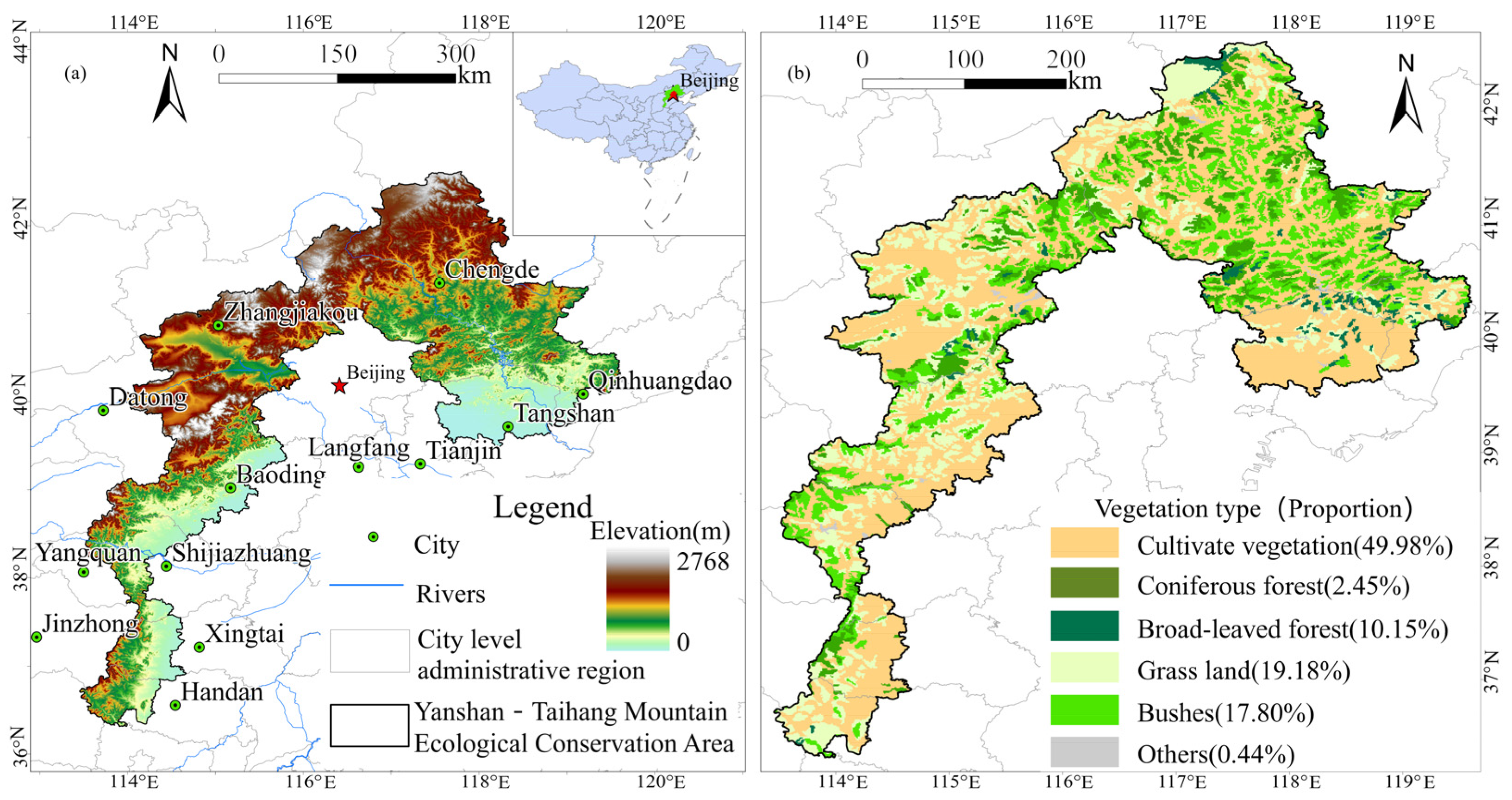

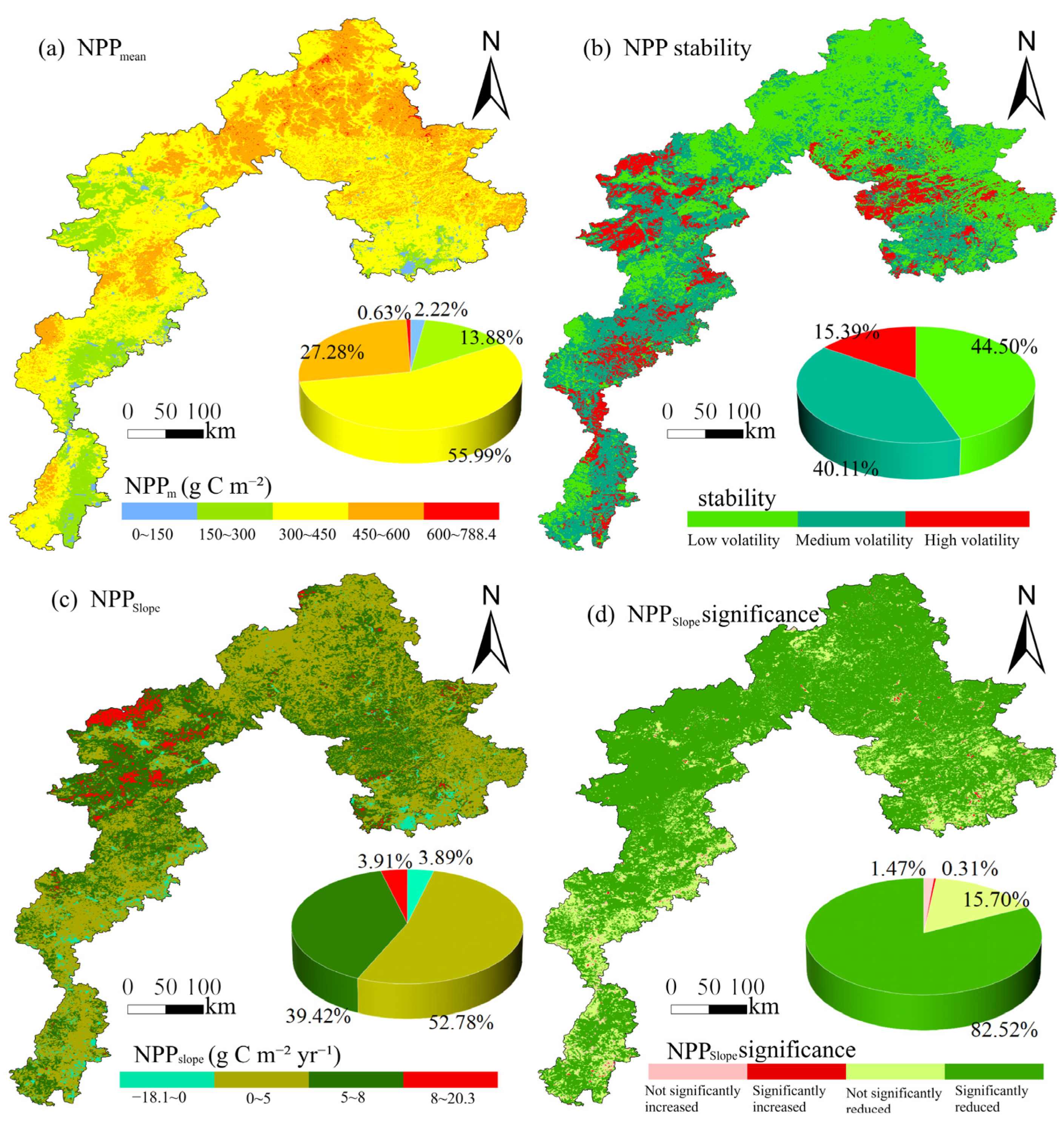
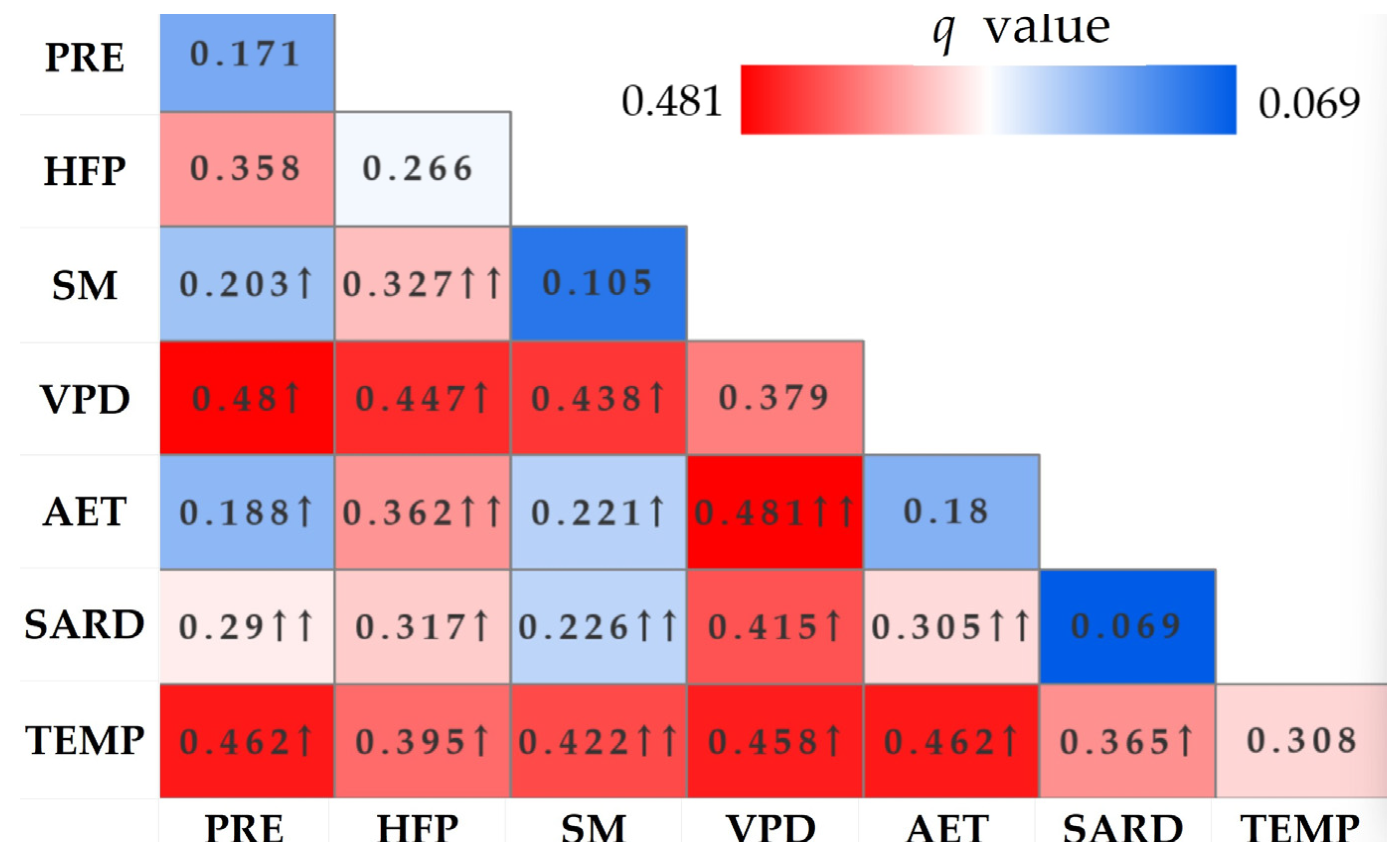
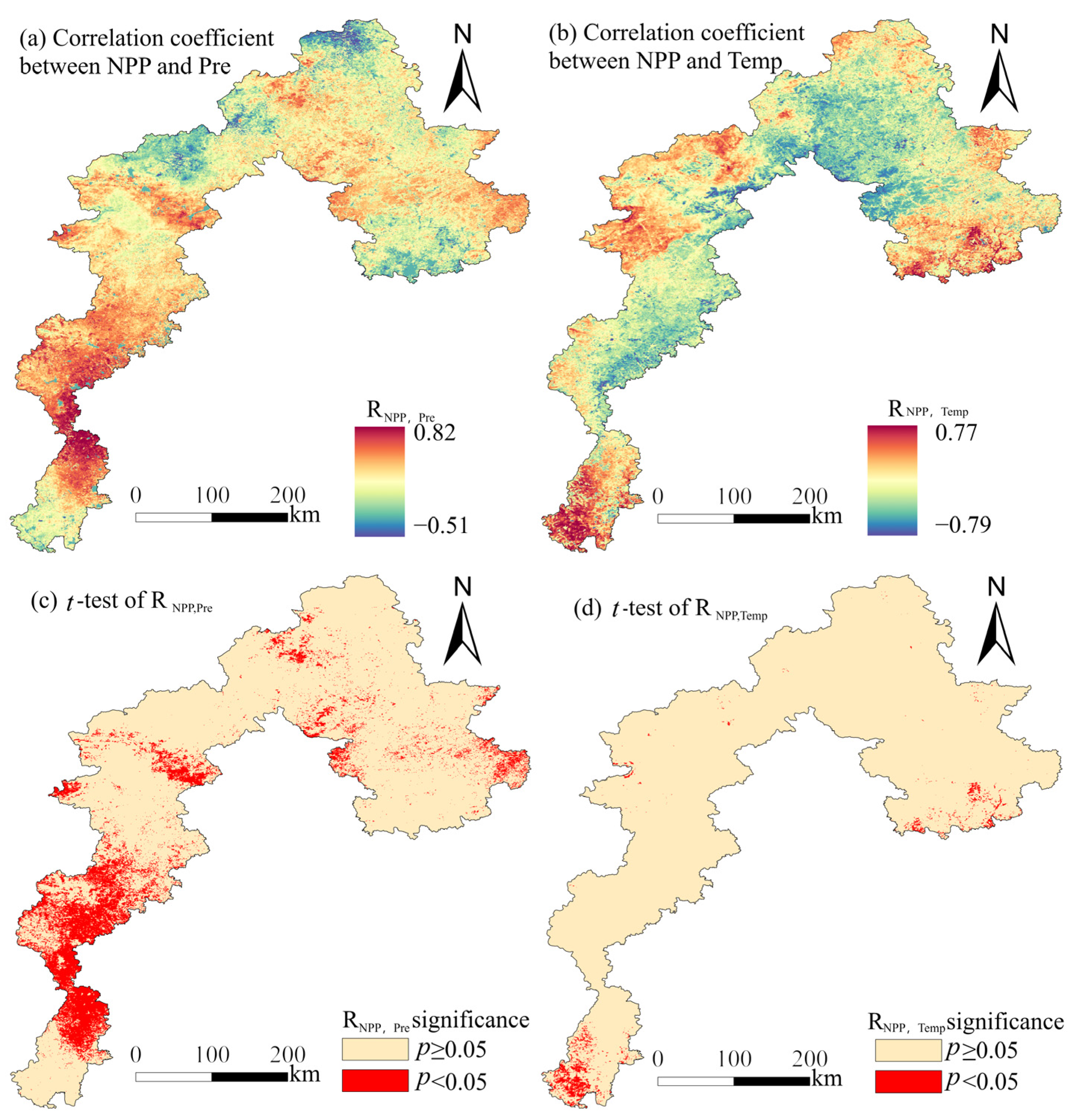

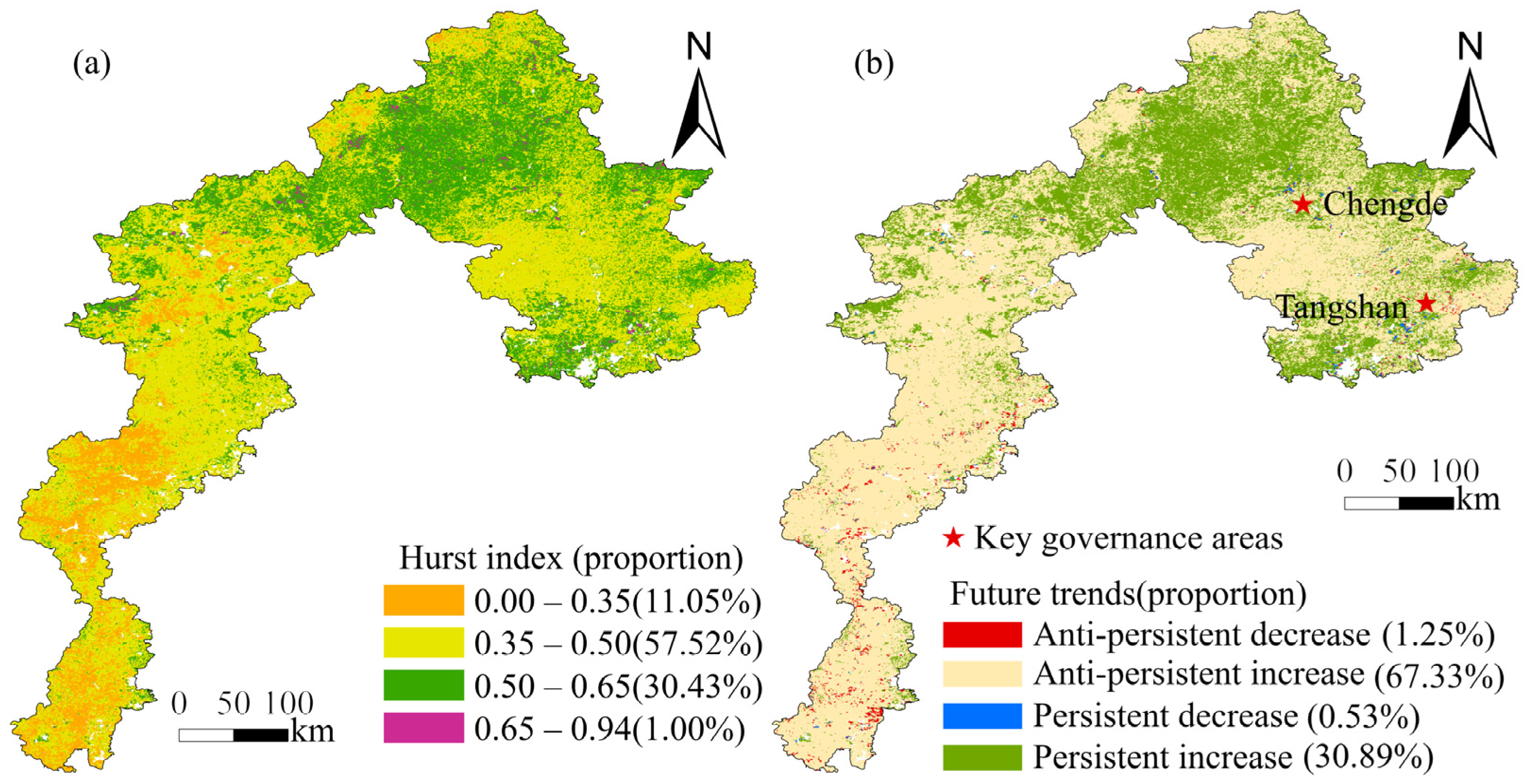
| Data Category | Variable Name | Temporal Range | Resolution | Source/Platform |
|---|---|---|---|---|
| Vegetation Productivity | Net primary productivity (NPP) | 2004–2023 | 500 m | MODIS MOD17A3HGF V6 (https://ladsweb.modaps.eosdis.nasa.gov/) (accessed on 25 December 2024) |
| Climatic Data | Average annual temperature and annual precipitation | 2004–2023 | 4000 m | TerraClimate dataset (https://developers.google.com/earth-engine/datasets/catalog/IDAHO_EPSCOR_TERRACLIMATE (accessed on 25 December 2024) |
| Land Cover | Vegetation types | 1990–2000 | 1000 m | Resource and Environment Science Data Center (https://www.resdc.cn/) (accessed on 25 December 2024) |
| Topography | Altitude (DEM) | — | 90 m | United States Geological Survey (USGS) (https://earthexplorer.Usgs.gov/) (accessed on 25 December 2024) |
| Environmental Variables | Vapor pressure deficit (VPD) | 2004–2023 | 500 m | RESDC (https://www.resdc.cn/) (accessed on 25 December 2024) |
| Soil moisture (SM) | 2004–2023 | 500 m | RESDC (https://www.resdc.cn/) (accessed on 25 December 2024) | |
| Solar radiation (SR) | 2004–2023 | 500 m | RESDC (https://www.resdc.cn/) (accessed on 25 December 2024) | |
| Anthropogenic Pressure | Human Footprint Index (HFP) | 2004–2022 | 500 m | Figshare Repository (https://figshare.com/) (accessed on 25 December 2024) |
| Impact Factor | VPD | TEMP | HFP | PRE | AET | SM | SR |
|---|---|---|---|---|---|---|---|
| q-value | 0.480 | 0.462 | 0.358 | 0.171 | 0.180 | 0.105 | 0.069 |
Disclaimer/Publisher’s Note: The statements, opinions and data contained in all publications are solely those of the individual author(s) and contributor(s) and not of MDPI and/or the editor(s). MDPI and/or the editor(s) disclaim responsibility for any injury to people or property resulting from any ideas, methods, instructions or products referred to in the content. |
© 2025 by the authors. Licensee MDPI, Basel, Switzerland. This article is an open access article distributed under the terms and conditions of the Creative Commons Attribution (CC BY) license (https://creativecommons.org/licenses/by/4.0/).
Share and Cite
Yi, M.; Zhang, D.; An, Z.; Cong, P.; Li, K.; Liu, W.; Sui, K. Spatiotemporal Dynamics and Drivers of Vegetation NPP in the Yanshan-Taihang Mountain Ecological Conservation Zone from 2004 to 2023. Sustainability 2025, 17, 9552. https://doi.org/10.3390/su17219552
Yi M, Zhang D, An Z, Cong P, Li K, Liu W, Sui K. Spatiotemporal Dynamics and Drivers of Vegetation NPP in the Yanshan-Taihang Mountain Ecological Conservation Zone from 2004 to 2023. Sustainability. 2025; 17(21):9552. https://doi.org/10.3390/su17219552
Chicago/Turabian StyleYi, Mingxuan, Dongming Zhang, Zhiyuan An, Pengfei Cong, Kuan Li, Weitao Liu, and Kelin Sui. 2025. "Spatiotemporal Dynamics and Drivers of Vegetation NPP in the Yanshan-Taihang Mountain Ecological Conservation Zone from 2004 to 2023" Sustainability 17, no. 21: 9552. https://doi.org/10.3390/su17219552
APA StyleYi, M., Zhang, D., An, Z., Cong, P., Li, K., Liu, W., & Sui, K. (2025). Spatiotemporal Dynamics and Drivers of Vegetation NPP in the Yanshan-Taihang Mountain Ecological Conservation Zone from 2004 to 2023. Sustainability, 17(21), 9552. https://doi.org/10.3390/su17219552





